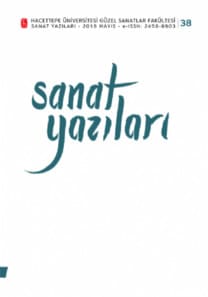YENİ MEDYA SANATI: YENİ BİR FELSEFE, YENİ BİR VARLIK DÜZENİ
NEW MEDIA ART: A NEW PHILOSOPHY, A NEW ONTHOLOGY
___
Baudrillard, Jean. (1983). Simulations. New York: Semiotext(e).Crary, Jonathan. (1992). Techniques of the Observer: On Vision and Modernity in the Nine- teenth Century. Cambridge, Mass.: MIT Press.
Deleuze, Gilles. (1994). Difference and Repetition. London: Athlone Press. The Topological Media Lab, Erişim: 14.06.2016. http://topologicalmedialab.net/xinwei/classes/readings/
Deleuze/Difference-and-Repetition/English/DifferenceRepetition01.pdf Hansen, Mark. (2004). New Philosophy for New Media. Cambridge, MA: MIT Press.
Kittler, Friedrich. (1999). Gramophone, Film Typewriter, tr. Geoffrey Winthrop-Young and Michael Wutz, Stanford, Calif.: Stanford University Press.
Lenoir, Tim. (2004). "Haptic Vision: Computation, Media, and Embodiment in Mark Hansen's New Phenomenology", foreword to Mark Hansen B.N. Hansen's New Philosophy of New Media. Cambridge, Massachusetts London: The Mit Press.
Lévy, Pierre. (1998). Becoming Virtual: Reality in the Digital Age. New York: Plenum Trade.
Manovich, Lev. (2001). The Language of New Media. Cambridge, Massachusetts: The MIT Press/Leonardo Books.
Mitchell, William J. (1992). The Reconfigured Eye: Visual Truth in the Post-Photographic Era. Cambridge, Mass.: MIT Press.
Paul, Christine. (2008). "Introduction" New Media in the White Cube and Beyond Curatorial Models for Digital Art. Christiane Paul (Ed.), Berkeley, LA, London Uni. of California Press.
Quaranta, Domenico. (2013). Beyond New Media Art. Brescia: Link Editions.
- ISSN: 2458-8903
- Yayın Aralığı: 2
- Başlangıç: 2001
- Yayıncı: -
MODERN VE POSTMODERN DÖNEMİN MÜZİĞE YANSIMALARI
MEHMET GÜNEŞ AÇIKGÖZ, TURAN SAĞER
YENİ OLANAKLARIN MELEZLİĞİ: YENİ MEDYA SANAT FORMU OLARAK VİDEONUN DEĞİŞEN YAPISI
MAĞAZA İÇ MEKAN TASARIM BİLEŞENLERİ
YENİ MEDYA SANATI: YENİ BİR FELSEFE, YENİ BİR VARLIK DÜZENİ
TÜRKİYE'DE BİLİMKURGU ÇİZGİ ROMANININ GELECEĞİ
FENOMENOLOJİK AÇIDAN 20. YÜZYIL SANATINDA GERÇEKLİK ALGISI
FIRAT ÇALKUŞ, CEMİLE ARZU AYTEKİN
HAREKETE DAYALI MİMARLIĞI YENİDEN DÜŞÜNMEK
PREFABRİKASYONUN TARİH İÇERİSİNDEKİ GELİŞİMİ AND MEKAN BİÇİMLENİŞİNE ETKİSİ
